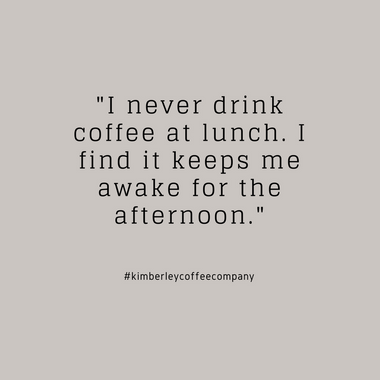Tell Me About Decaf Coffee!
Posted by Mark Bentham, The Coffee Man on 26th Nov 2018
How do they take out the
caffeine?
Does it taste as good?
Can you recommend me some great
decaf?
These are questions I am asked a LOT at the Coffee Van and do love to share answers relating to burning coffee questions. So I will try answer the burning question of To Decaf or to Not Decaf here, as well as un-mystify the mystery of HOW THE HELL DO THEY GET THE CAFFEINE OUT???
Decaffeinating coffee was invented by Ludwig Roselius in 1905, after he believed his fathers death was due to overstimulation by coffee drinking. No studies or proof is related to this legend, but we are indeed grateful that someone in history loved coffee so much he wanted to preserve the ability to drink it without the caffeine hit!
Firstly, let me give you a non-scientific overview of how caffeine is removed from coffee.
Here we go…
How do they make the coffee decaffeinated?
There are different types of caffeine removal - all quite similar in concept but the beans are treated with different (or no) chemicals and/or organic elements.
The processes are all conducted when the beans are still green (unroasted) and whole. And since caffeine is a water soluble substance, water is used in all decaffeination processes.
Solvent Based Decaffeination
Basically, the coffee beans are washed and soaked in a solvent that is usually made up of water, organic solvents or carbon dioxide. This solvent slowly removes the caffeine from the beans with the end result being a lovely coffee bean that is caffeine free.
All solvent based processes use a decaffeinating agent (such as methylene chloride, activated charcoal, CO2, or ethyl acetate). Which makes sense as they are called Solvent Based Decaffeination Processes! These agents help speed up the process and minimize the “washed-out” effects that water alone would have on the taste of decaf coffee.
The solvent based decaffeination process involves adding a solvent to boiling water that the beans are washed in for around 10 hours. This increase the caffeine absorption into the water through activating the process using the solvent. The water is then filtered, removing the large caffeine molecules, and separating the solvent away from the liquid. The beans are then re-steeped in the (caffeine and agent removed) solution which contains all the beautiful minerals and elements that soak back into the beans bring great flavour – allowing them back into the bean. All that extraction and re-absorption sounds tiring right!!
Some solvents that are used widely include methylene chloride and ethyl acetate. Ethyl acetate is actually considered the best of the solvents, being a more natural compound as it is extracted from ripening fruits. Coffee that has been processed using ethyl cetate can be branded as Naturally Decaffeinated. All solvents used now are completely safe, and nasty chems like benzene, trichloroethylene, dichloromethane and even chloroform (eeek!!!) that have been used in the past are now banned.
Swiss Water Process
The Swiss Water Process is well known as being the best method for decaffeinating organic beans, and is Kimberley Coffee Company’s chosen process for treating our beautiful beans the most lovingly.
This method relies entirely on solubility and osmosis to decaffeinate coffee beans and does not use any chemicals or added compounds to the process.
The green beans are first soaked in very hot water to dissolve the caffeine from them. The water is then drawn through a carbon filter which is pours enough only for smaller flavour and oil molecules to pass through, leaving the caffeine behind.
The remaining beans are now caffeine and flavour free, and the separate water solution (called a Green Coffee extract) contains all the caffeine and flavour molecules.
Here is where it gets tricky! The beans that have been decaffeinated and are now flavourless are discarded. Yes! Gone! A fresh batch of green beans is now steeped in the flavour rich solution. Being that the solution is actually saturated with flavours, it cannot draw any extra flavour from the new beans, but only the caffeine extract. Only the caffeine moves out of the beans, leaving all the flavour still in the new batch.
This method takes a longer time than the solvent based process, and is considered to be a much healthier, the most natural, and best flavour retaining way to decaffeinate. The principals of osmosis and total saturation point cleverly working to enable you to sleep And enjoy coffee!
But how does it taste?
Getting the best decaf is important, not only because you want to have great quality beans that are free trade, organic and sustainably grown, but because you are a coffee lover and want to enjoy that delicious taste even if you prefer a non-buzz style cup.
We have found that the Swiss water Process gives the best result in the flavour department, because the flavour does not need to travel out and back into the bean. We also love that no additional solvents (even natural compounds) are used in the process. It is 100% beans.
People find that decaf gives a milder, less bitter taste than its caffeinated cousin, and some really prefer this. This is because caffeine is actually part of the coffee complexity that offers the more bitter, acidic end of the taste spectrum.
What is the best Decaf?
Try our star decaf blend next time you make an online order with us. The Alnair Swiss Water Organic Fairtrade Blend. This multiple box ticking blend was named, like all our star coffees, by Astro Tours Legend, Greg Quicke, after a star found in the Kimberley skies. Alnair is the brightest star in the southern constellation Grus. Its first depiction in a celestial atlas was in Johann Bayer's Uranometria of 1603. We have 250g, 500g or 1 kilo packs are roasted as you order and sent within days of roasting.
It doesn’t get better than that!
